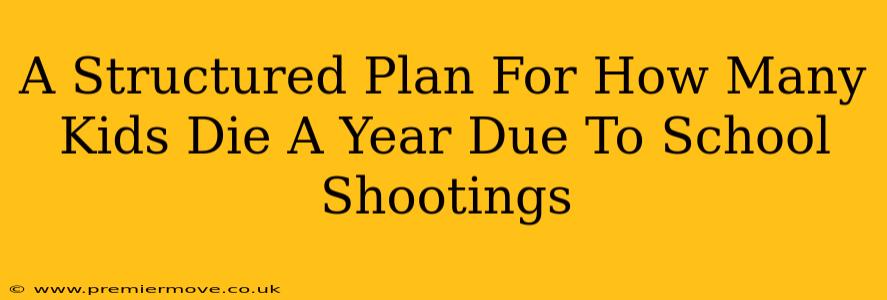A Heartbreaking Look at School Shooting Fatalities: Understanding the Numbers and the Need for Change
The tragic reality of school shootings casts a long shadow over communities worldwide. While precise, globally consistent data is difficult to obtain, understanding the scope of child fatalities due to these events is crucial in fostering meaningful change. This structured plan outlines how we can approach understanding this heartbreaking statistic.
1. Defining the Scope: What Constitutes a "School Shooting"?
Before we can even begin to calculate numbers, we must define our parameters. What constitutes a "school shooting"? This isn't simply a matter of a gun being fired on school property. We need to consider:
- Location: Does the incident need to occur on school grounds, or does it include incidents near schools, targeting students or staff?
- Perpetrator: Should the shooter be a student, a stranger, or someone else affiliated with the school?
- Intent: Are accidental shootings included, or do we focus solely on intentional acts of violence?
Consistent criteria are essential for accurate data collection. Without a clear definition, any resulting statistics will be unreliable and potentially misleading.
2. Data Collection: Navigating the Challenges
Gathering reliable data presents significant obstacles. Many countries don't have centralized, publicly accessible databases tracking school shootings. Even within countries with such systems, data quality and reporting practices can vary significantly. Consider these challenges:
- Data Silos: Information may be scattered across various agencies (law enforcement, education departments, healthcare).
- Underreporting: Incidents might go unreported or be downplayed, particularly in regions with strict censorship or cultural sensitivities.
- Definition Discrepancies: Inconsistent definitions of what constitutes a "school shooting" make cross-country comparisons difficult.
3. Analyzing Available Data: Spotting Trends and Gaps
While a perfect global dataset is elusive, researchers and organizations diligently collect and analyze available information. By focusing on reputable sources and using consistent methodologies, we can gain a better understanding of the issue, even with limitations:
- Focus on Specific Regions: Concentrating on individual countries or regions with reliable data provides a more accurate picture at a smaller scale.
- Qualitative Research: Complementing quantitative data with qualitative research (interviews, case studies) can illuminate the underlying factors and contextual information crucial for understanding the problem's nuances.
- Tracking Trends Over Time: Examining data over several years reveals patterns and potential shifts in the frequency and nature of school shootings.
4. The Importance of Context: Beyond the Numbers
It's vital to avoid reducing this complex issue to simply a number of yearly fatalities. The human cost behind these statistics is immense, extending far beyond the immediate victims. The emotional trauma experienced by students, staff, families, and communities is profound and long-lasting.
Understanding the socio-cultural factors that contribute to school shootings – including access to firearms, mental health resources, and societal attitudes towards violence – is equally important to preventing future tragedies. The number of deaths is a stark reminder of the urgent need for comprehensive, multi-faceted approaches to address this crisis.
5. Moving Forward: Advocacy and Action
The quest for accurate data on school shooting fatalities is not merely an academic exercise. It is a crucial step in informing policies, allocating resources, and fostering effective prevention strategies. By actively engaging with organizations working towards safer schools, supporting mental health initiatives, and advocating for sensible gun control measures, we can all contribute to making schools safer places for our children. The number of deaths should serve as a catalyst for positive change, not merely a grim statistic.

